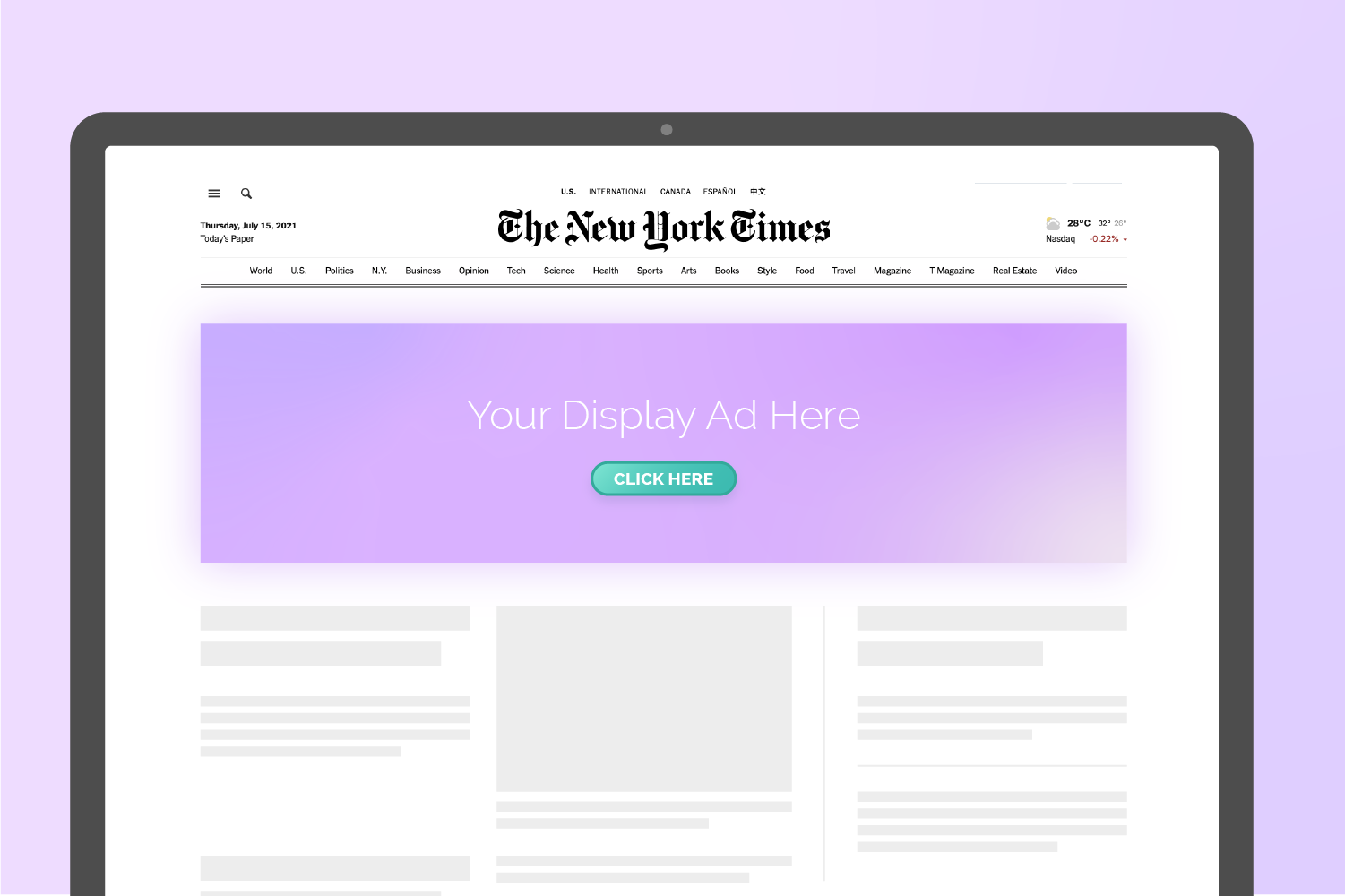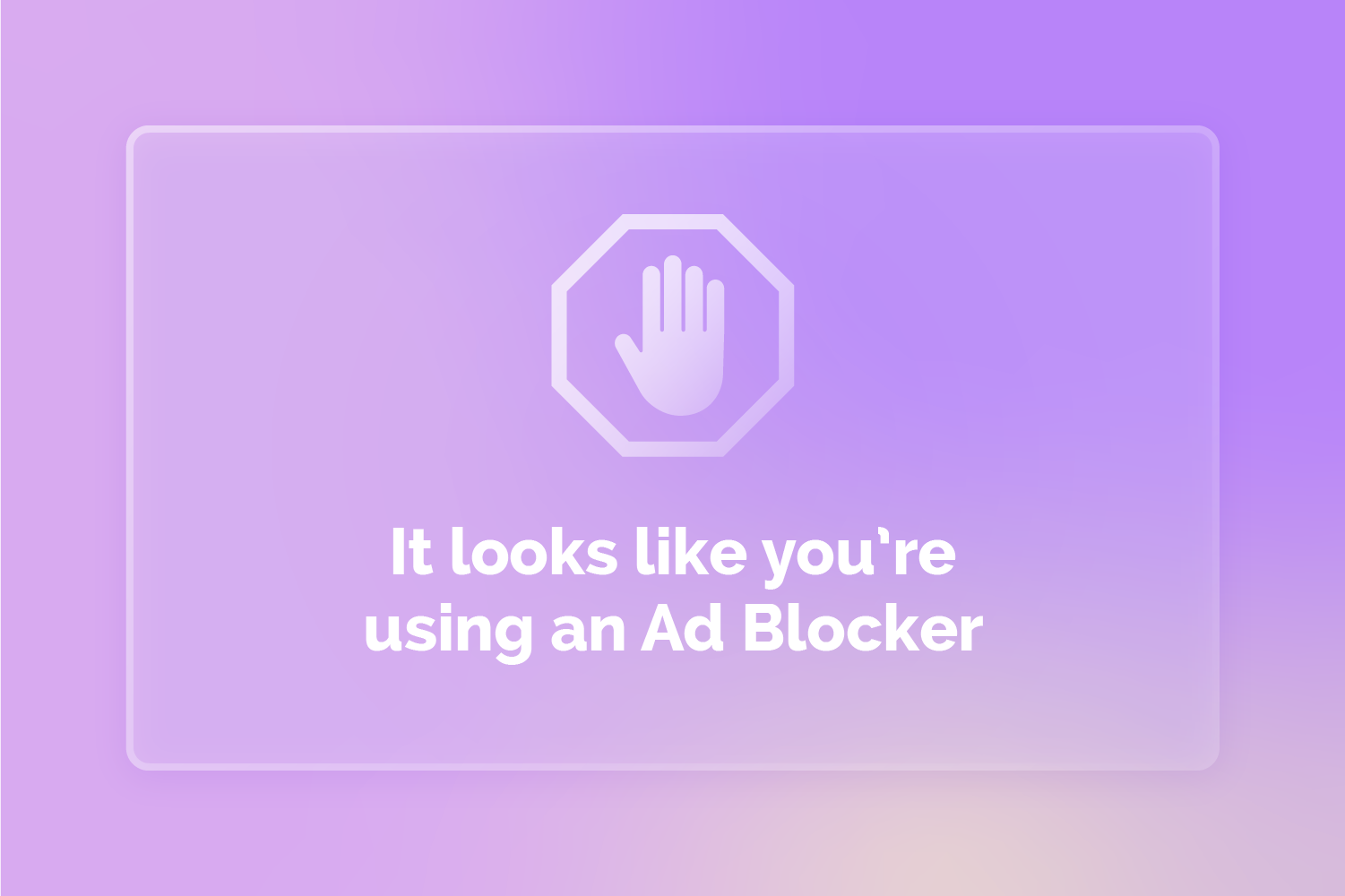A milestone in history. This moment was the birth of what is now almost a 200 billion industry in the US alone, the birth of digital advertising.
Display banners were the first ad format ever used in digital advertising, long before search, mobile, video, native, audio or social ads. The industry evolved quite a bit, especially in the last 20 years as technological advances made more forms of digital advertising possible.
Display ads are a form of paid media compared to owned media like websites, blogs or earned media like social networks.
Websites have huge audiences who consume the content on each website. To monetize the content, website owners often sell ad space (i.e. banner slots) to advertisers, which use the space to display their ads.
The display ad ecosystem , in 2022, has 1000s of companies (publishers, agencies, tech providers) involved. It has become hard to navigate this landscape due to the number of tech offers that deliver your ads in the best and efficient way possible. Programmatic advertising (our specialty at Grapeseed Media!) is a streamlined way of buying and selling display ads.
In this guide, we’ll walk through the different types of display advertising, how to best use them, and what the benefits are for agencies.
Types of display ads
Let’s take some examples first. It’s best to take a look at the IAB (Internet Advertising Bureau) for specifications on standard display banner ads. The most common sizes are 728×90, 300×250 and 160×600 (or sometimes the 300×600) for desktop. The dimensions are in px – pixel – so relative to the resolutions of your screen.
Nowadays, display ads can be found in different channels, on desktop, mobile and as rich media or native ad formats. The predominant sizes on mobile are 300×250 and 300×50 (320×50).
Rich media ads are mostly high-impact formats like billboards (970×250), but they differ not only by size but also by their interactive elements that are more advanced than normal standard display ads.
Native ads are distinctive because of their ability to seamlessly integrate into the content of the website. They match the look and feel of a website. They are harder to differentiate from the content so they must be explicitly identified as paid ads with terms like “sponsored by” or “powered by”.
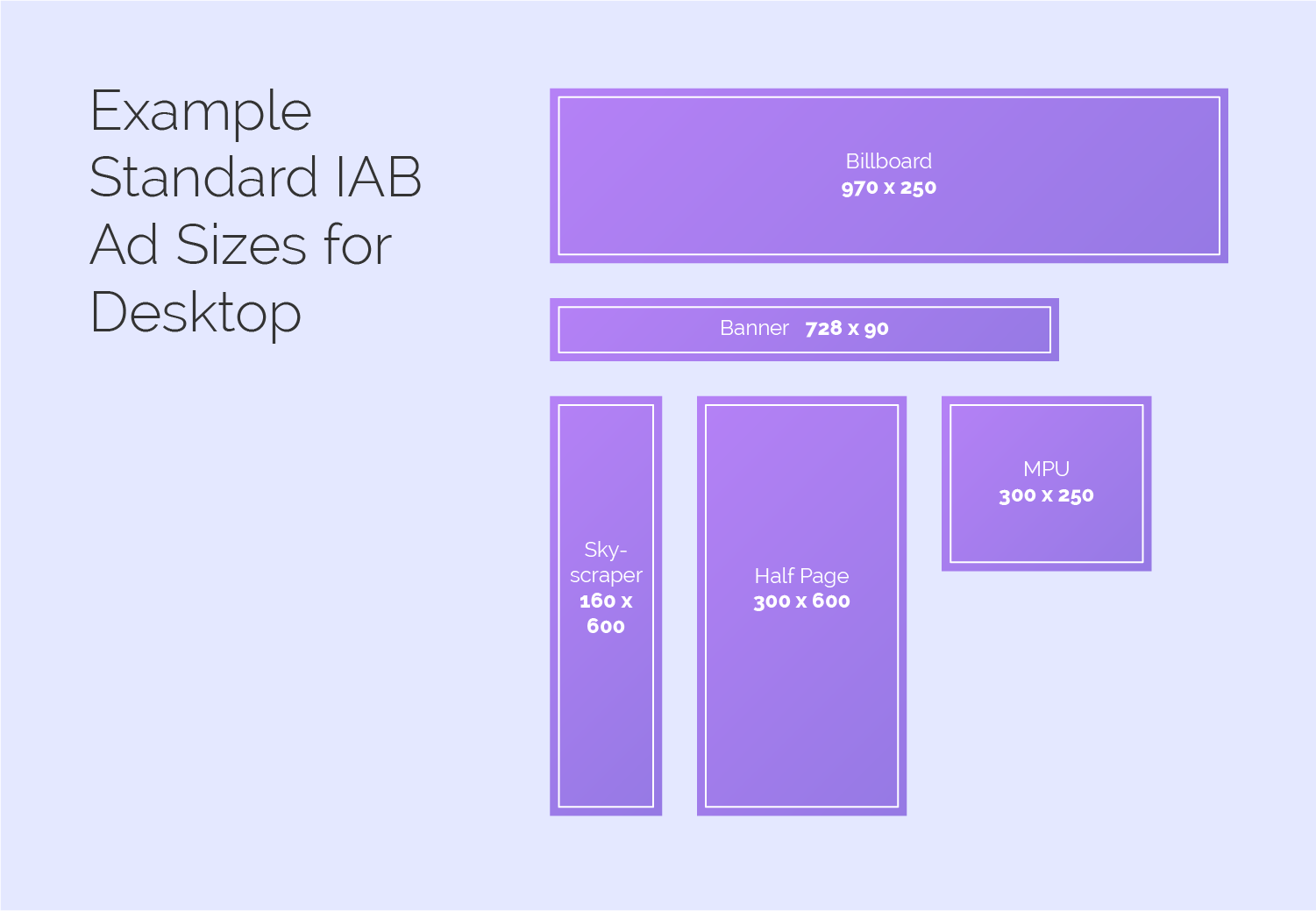

IAB standard ad sizes
How do display ads work?
Ads are delivered by ad servers. There are ad servers for publishers (i.e. websites) and there are ad servers for advertisers.
Publisher ad servers focus on the ad inventory management and inventory distribution as well as ad monetisation of the publisher’s ad inventory.
Advertiser ad servers focus on creative management and ad delivery reporting.
The ad itself is delivered in an ad tag. An ad tag is just a piece of html5 code which is implemented in the advertiser’s ad server and is then served into the ad unit slot that is offered by the publisher ad server.
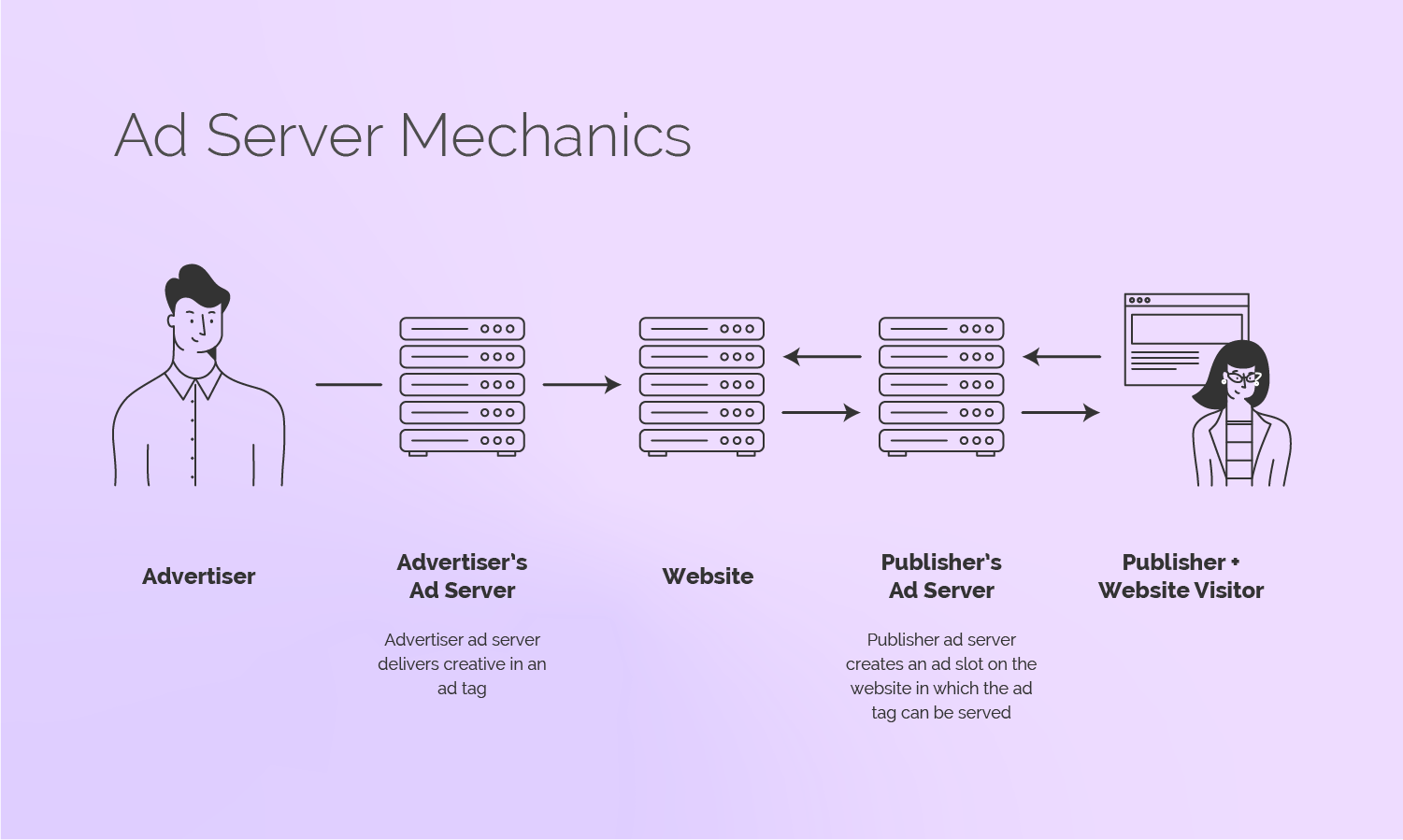
The mechanics of an ad server
How are display ads purchased?
Ads are mostly bought on CPMs, cost-per-mille, meaning the cost per thousand impressions. An impression is counted once an ad is displayed on a website. Other buying models are CPC, cost-per-click, which is predominantly used in search or in display networks.
Programmatic advertising, which is a modern and efficient way of delivering display ads, has been gaining huge popularity in the last couple of years. In 2021 89.3% of the advertising is forecasted to be transacted programmatically according to eMarketer. Programmatic advertising uses a real-time bidding model. In less than 100ms an ad impression on a website is auctioned and served to the highest bidder.
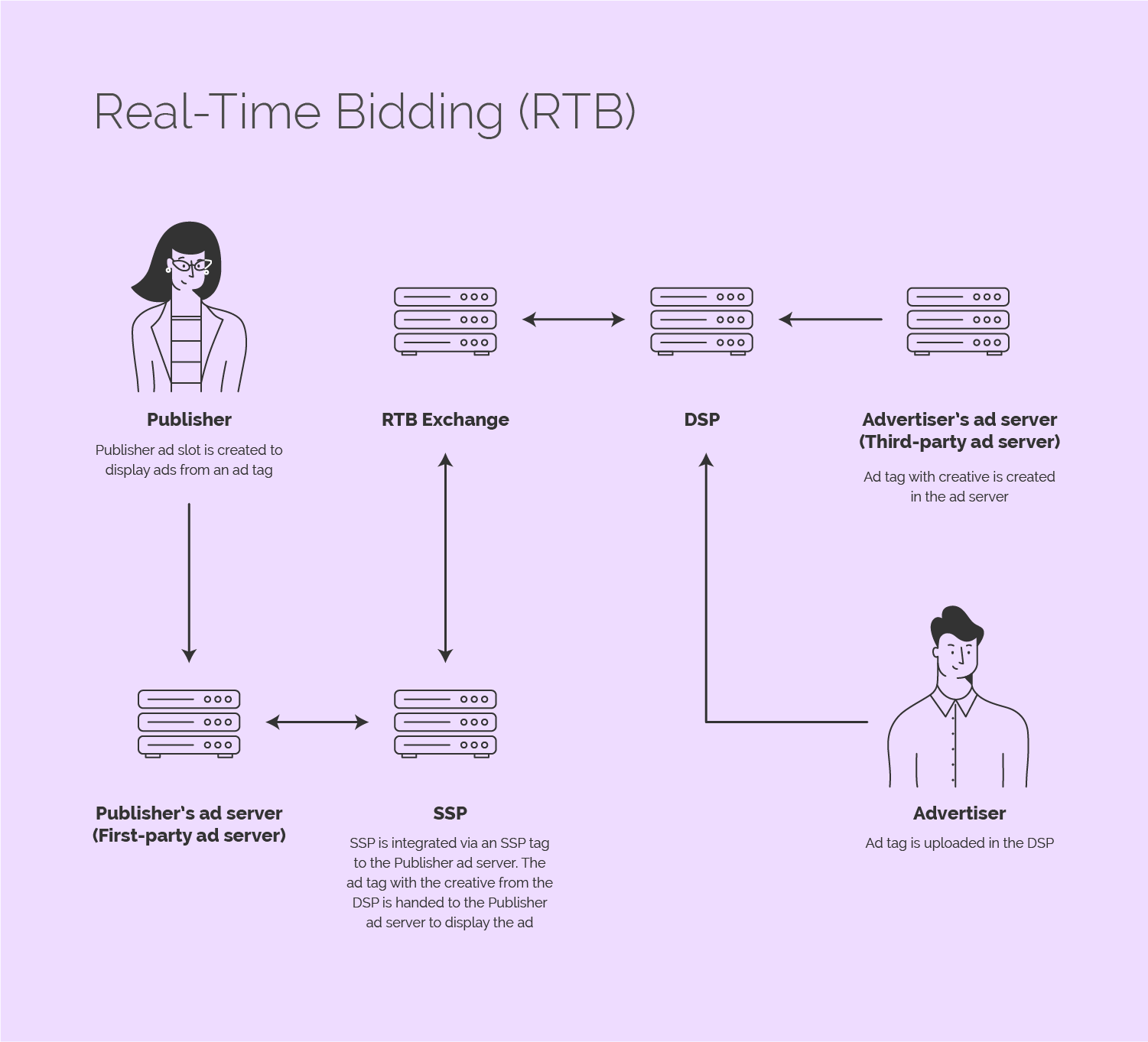
RTB mechanics
What are the advantages of display ads?
Here are the advantages of display ads:
Variability: Display ads come in multiple sizes, from large billboard formats (970×250), placed above the fold, to smaller MPUs (300×250) placed at the end of an article or a skyscraper (160×600) at the side of the content. For every campaign objective you will find a format that suits your needs for the design of your creatives. You can also use dynamic creative optimization (DCO) to serve customized ads (i.e., different pictures or motifs, different copy text) based on their personal preferences.
Scale: The reach of display ads is astronomical. Programmatic has a footprint of 3.5 BN users (bigger than Facebook and YouTube) — 11.5 million ad opportunities are evaluated every second: 790 billion ad opportunities per day with the ability to reach over 819 million users’ devices.
Cost-effectiveness: Because of its tremendous scale, display ads tend to clear at lower CPMs than formats in other digital channels.
Measurability: Display ads allow you to easily measure success to corresponding business outcomes (i.e. conversions). You can collect data around whether someone clicked your ad and how long they interacted with it meaning you can adjust your display ad strategy easily.
Partner well with other strategies: Display ads partner particularly well with other, more specialized digital channels, like search, social, video or content marketing activities. You can use display advertising as a brand-building tool or as a traffic driver in conjunction with other measures. You can retarget people who have watched your online video ads with banners or retarget people who have been reading your blog with banners to offer them a discount on your products as an example.
Versatile targeting options: Display ads offer plenty of powerful targeting options: keywords, demographic, URL-based, IAB Categories, third party data (behavioral, interest or in-market data), mobile location data (like visiting certain stores) or 1st Party data (data from your own digital properties). This means your ads can be personalised to different audiences.
How display ads support the whole consumer journey
When making display ads, consider the consumer journey. Consumer journey frameworks usually consist of roughly 3-5 phases and demonstrate how consumers are going through their decision-making journey in a buying process. Let us focus on 3 phases in the journey in this article.
Awareness – The top of the funnel. Marketing activities in this phase are all about brand awareness and brand building. For example, reaching new customers that are not yet aware of the brand or product. An ad with a ‘learn more’ call to action (CTA) to a whitepaper on a topic is an example of an awareness ad.
Consideration – The mid funnel. People are in-market for your product or familiar with your brand but have not yet made up their mind which brand or product to go for. They are still considering their options.
Conversion – The bottom of the funnel. These are repeated customers, or customers that are very close to buying your product, because they have been on your website, searched for your business or enquired about you in some way. These users just need a reminder or a little nudge to get them to convert. An ad with a ‘Buy now’ call to action would be an example of a conversion display ad.

The consumer journey
Some tips for effective display ads
The most important thing when it comes to display advertising is having a strategy. A campaign strategy includes deciding on a campaign objective, conversion goals and a clear vision on how to achieve the campaign goals in each step of the funnel. If this strategy is set, you can optimize towards your goal consistently and methodically.
Hence, the first tip for a successful display advertising campaign would be to set clear campaign goals and KPIs for different phases in the funnel. KPI’s for awareness could be unique reach or video completion rate. For consideration – landing page visitors, brochure downloads, store locator visits or time spent on site. For the bottom of the funnel, think of all conversion related goals, purchase events, app downloads or lead form completions.
Segment your audience: Prospecting vs. Retargeting. Prospecting is a top and mid funnel activity – meaning a focus on new customers rather than existing customers. In prospecting you target people who most likely haven’t been to your website. You can use data or contextual targeting to address these audiences that belong to your target audience, but have not yet heard of your business. Retargeting relates to a mid or bottom funnel activity. Here you are aiming to re-engage with your existing website audience. People who have already visited your website are more likely to be in the consideration or conversion phase so you can serve them display ads that are further down the funnel.
Use a variety of targeting options: In order to maximise the full potential of the marketing platforms in displaying advertising, use all targeting options available. From affinity, to keyword, to 1st party data. Use different targeting methods and see what works best for you in your campaigns.
Use a variety of formats and different creatives: Try different display formats and see what creatives work well.
Switch creatives out to avoid creative fatigue: To prevent creative fatigue or banner blindness, switch your creatives out every 2-3 months at the latest.
DCO (Dynamic Creative Optimization): You can use your first party data to customize the creative messaging and enrich the creative with relevant information for the consumer.
Finally, be patient and give the campaigns some time. The systems need time to test and learn, so in the beginning results may have a lot of room for improvement, but the system gradually learns and adjusts over time. This patience will pay out later on, when the return on your ad spend is growing exponentially.
How can an agency help you get started with display ads?
It is a lot to digest when you are at the beginning of your digital marketing journey. Therefore, it is a good idea to engage a display ad partner to jumpstart your marketing activities. Programmatic agencies like Grapeseed Media can help you with the following:
- Programmatic agencies employ experts which are specialised and highly qualified in this specific programmatic marketing skill set. They are at the cutting edge of the technology and will yield you the best results. Moreover, they are well versed with other digital marketing tools as well.
- There can often be a barrier to entry due to minimum buys. However, partnering with display ad specialists like Grapeseed means you have more negotiating power thanks to our buying volume.
- It will take a while until you have a working marketing tech stack set up. That does not happen overnight. It takes knowledge, effort and time and it can be frustrating in the beginning, especially when you are also focussed on scaling and operating your business. With the help of an agency, you do not have to wait and spend precious time on this. The systems are already in place from the get-go and your campaigns can go live in no time.
- Agencies offer access to better and more advanced tools. Also, they can help with the selection of marketing tools that are the best fit for your marketing program. Yes, you can work with some of the tools that are available with just the use of a credit card, i.e., Google Ads. But bear in mind, that those systems are extremely limited in their options and might not be the best fit for you.
- Access to more resources & troubleshooting capabilities – When you are scaling up your business, you are most likely working on a lean team, and you will probably need to outsource certain parts of your marketing activities to external agencies. Grapeseed Media acts like an extension of your core team. Grapeseed’s marketing experts work hand in hand with your team to fast track your campaign and troubleshoot any issues with your campaigns right away.
- Agencies can help to Identify further marketing opportunities by delivering detailed insights derived from reporting. Opportunities that might be unbeknownst to you and applied to future campaigns, help to elevate your marketing program to another level.
- Experience from other verticals and clients – Agency teams work across multiple clients and industries. This means that they have insights and experience from other verticals and/ or clients from the same industry which will help them to understand and optimise your campaigns better.
In conclusion
Especially in these times, during and even after the Covid-19 pandemic, consumer behavior and media consumption has changed dramatically. Display advertising is not only a great way to market your product. Nowadays, your digital marketing activities are essential to your business success.
Display advertising is particularly crucial due to its many advantages like the extraordinary scale, the cost effectiveness, and the variability, which makes display advertising an essential tactic throughout each phase of the consumer journey.
Learn more about how Grapeseed Media can help you get started with display advertising.

